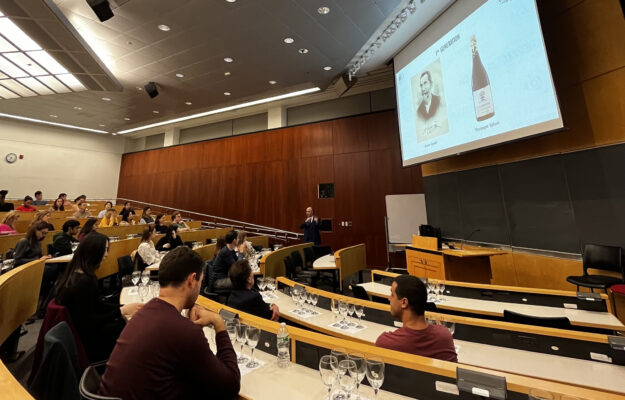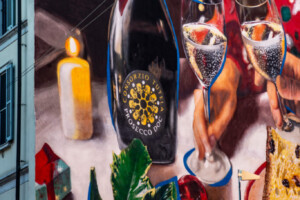“Today the world can observe and admire the amazing landscape made up of vineyards that embellish kilometers and kilometers of hills, while instead, in 1853 there was only one small producing vineyard. Now, instead, there are more than 9.000 hectares on those hills cultivated with the Glera grape vine - the basis of Prosecco Superiore DOCG. And, the key element that earned them UNESCO recognition is the care with which they are managed”, said Domenico Scimone, CEO of the Carpenè-Malvolti winery during his lecture on the history of Prosecco DOCG and the UNESCO territory of the Conegliano and Valdobbiadene hills, invited by the prestigious Columbia University in New York to narrate the origins and story of what would become, thanks to Antonio Carpenè the most famous Italian sparkling wine in the world. This was not the first time the Carpenè-Malvolti winery has had the privilege of being invited by Columbia University as well as other Universities in Italy and on the international level, to talk about Prosecco, its history and the man who created it 155 years ago, Antonio Carpenè.
The lecture was developed in three phases. First of all, the story of the territory, second, the history of the family and thirdly, tasting the premium and super premium sparkling wine selections. Carpenè Malvolti explained that the intriguing journey began in that territory, and thanks to the active contribution of the company’s founder, Antonio Carpenè, has developed over the last century and a half, and is now a top destination for experiential food and unprecedented wine tourism. The driving force is the thirst for knowledge about the origins of this Made in Italy symbol, and how it grew to become one of the most consumed sparkling wines”.
How to care for and manage the territory and the vineyard, Scimone said, has continued to this day. It has been handed down to the farmers who, in turn, had learned it by listening to the lessons that Antonio Carpenè himself held in town squares in the mid-nineteenth century. The aim of his technical indications was to instruct winemakers in the art of optimal management of the vineyard. They not only brought great wealth to the area in terms of harvests, but they also convinced families to stay where they had settled, and therefore contribute significantly to growing in economic and social well-being. It was definitely a pioneering vision, a dream that today is a solid reality, made up of an inseparable bond between companies and denomination.
Like the bond between Carpenè-Malvolti and the territory that transcends the simple geographical location of the company, as the one intertwines with the development of the other, and vice versa. This is why the guest lecturer of the historic winery at Columbia University focused on the value of Prosecco as well as the overall context in which it is placed. Since then, Scimone continued, 5 generations have taken turns at the helm of the winery. Antonio Carpenè, in 1868, realized the potential in the grapes of this native vine to be able to compete with French Champagne. He studied, researched and created an ad hoc sparkling winemaking method around it that would enhance it to the maximum. Etile Carpenè, the second generation, was also a pioneer and in 1924 marked a turning point in corporate communication by writing, for the first time, the term Prosecco on the label, which gave a precise identity and a specific geographical location to this wine, and thereby anticipating, by 45 years, the creation of the denomination in 1969. Furthermore, he was a pioneer of the advertising message and ahead of his time, using testimonials and a commission of the first product advertising campaigns. Next in line, the third generation and the merit goes to Antonio Carpenè for having brought Prosecco to international markets through opening new commercial outlets that are still strategic today.
The lecture continued, highlighting that keeping up with the times is always an essential condition for running a business, and Etile Carpenè, the fourth generation, has made a fundamental contribution to technological adaptation and innovation in the work environment. The link between history and the future is Rosanna, the fifth generation, who has made the key element of her mandate involving new generations in the creation of a cultural message around Prosecco.
Carpenè-Malvolti has brought an in-depth historical study to Columbia University, to gain knowledge and understand the most important issues - agronomic and winemaking techniques - of the most "authentic" Prosecco, as the students present at the guest lecture defined the premium and super premium sparkling wine selections, during the tasting that concluded the lecture. The wines tasted were, “1924 Prosecco”, inspired by the strategic determination that put the name Prosecco on the label for the first time, the “1868 Rive” San Pietro di Barbozza, dedicated to the heroic harvest , which makes it an extremely special production, the "1868 Prosecco", an example of the historical and more traditional selection of Prosecco, and “Cartizze", the most prestigious selection of the denomination, whose grapes are cultivated on a very small area, just 108 hectares between the hamlets of Saccol, Santo Stefano and San Pietro di Barbozza.
The conclusion was an in-depth narrative of the qualitative pyramid of the “Prosecco territory”, which summarizes the territorial segmentation of the respective DOC and DOCG denominations (Asolo and Conegliano Valdobbiadene), highlighting all the expressive specificities was explored. The lecture included the DeVinimus Institute - The Columbia Law School Wine Society, at the Jerome Greene Hall of the Columbia Law School location. “DeVinimus”, Domenico Scimone CEO of Carpenè Malvolti, said, “is dedicated to expanding the knowledge and the promotion of fine wines from all over the world. Every year tastings are hosted with producers from different wine regions. Being given the opportunity to be one of the highly selected companies invited to tell their story in this prestigious context represented a unique and extraordinary occasion for Carpenè-Malvolti. Especially in relation to having the opportunity to interact with an audience of young professionals that are passionate about wine and interested in viticultural and winemaking knowledge”.
Copyright © 2000/2025
Contatti: info@winenews.it
Seguici anche su Twitter: @WineNewsIt
Seguici anche su Facebook: @winenewsit
Questo articolo è tratto dall'archivio di WineNews - Tutti i diritti riservati - Copyright © 2000/2025









































































































































































































